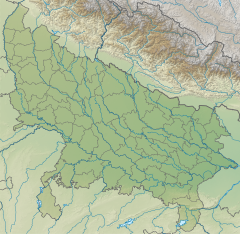उल नदी
| उल नदी Ul river | |
|---|---|
| स्थान | |
| देश |
|
| राज्य | उत्तर प्रदेश |
| ज़िले | पीलीभीत, लखीमपुर खीरी, सीतापुर |
| भौतिक लक्षण | |
| नदीशीर्ष | तराई दलदली क्षेत्र |
| • स्थान | पूरनपुर, पीलीभीत ज़िला, उत्तर प्रदेश |
| नदीमुख | काली नदी (चौका नदी, शारदा नदी) |
• स्थान |
सीतापुर ज़िला, उत्तर प्रदेश |
• निर्देशांक |
27°46′59″N 81°01′59″E / 27.783°N 81.033°Eनिर्देशांक: 27°46′59″N 81°01′59″E / 27.783°N 81.033°E |
| लम्बाई | 175 कि॰मी॰ (109 मील) |
| जलसम्भर लक्षण | |
| जलक्रम | उल → काली (शारदा) → सरयू (घाघरा) → गंगा |
| नदी तंत्र | गंगा नदी |
उल नदी (Ul river) या गोबरहिया नदी भारत के उत्तर प्रदेश राज्य में बहने वाली 175 कि॰मी॰ (109 मील) लम्बी एक नदी है। यह पीलीभीत ज़िले के पूरनपुर क्षेत्र में तराई के दलदली भागों में उत्पन्न होती है, और फिर लखीमपुर खीरी ज़िले और सीतापुर ज़िले में बहती है। बहराइच ज़िले के कनारखी नामक गाँव के समीप यह [घाघरा में विलय हो जाती है, जो स्वयं शारदा नदी या चौका नदी भी कहलाती है और सरयू नदी (घाघरा नदी) की उपनदी है। सरयू आगे जाकर गंगा नदी में विलय हो जाती है।[1][2][3][4][5]
विवरण[संपादित करें]
उल नदी अर्थात् गोबरहिया नदी लखीमपुर जिले से सीतापुर जिले के जहांगीराबाद, धरमपुर गोंड़ईचा, मुरकटिया, जानकीनगर, कुमह्ढ़ौरा, और रामपुर मथुरा होते हुए कनर्खी गाँव के पास घाघरा नदी में मिल गई है।[6][7]
इन्हें भी देखें[संपादित करें]
- काली नदी, उत्तराखण्ड
- सरयू नदी (घाघरा नदी)
- तराई क्षेत्र
- सीतापुर ज़िला
- पीलीभीत ज़िला
- लखीमपुर खीरी ज़िला
सन्दर्भ[संपादित करें]
- ↑ "बाढ़ पीड़ितों ने बनाया संघर्ष मोर्चा और फूंका बिगुल". jagran.com. अभिगमन तिथि 30 मई 2020.
- ↑ "रामपुर मथुरा के कई गांव बने टापू, फसलें डूबीं". jagran.com. अभिगमन तिथि 30 मई 2015.
- ↑ "Uttar Pradesh in Statistics," Kripa Shankar, APH Publishing, 1987, ISBN 9788170240716
- ↑ "Political Process in Uttar Pradesh: Identity, Economic Reforms, and Governance Archived 2017-04-23 at the वेबैक मशीन," Sudha Pai (editor), Centre for Political Studies, Jawaharlal Nehru University, Pearson Education India, 2007, ISBN 9788131707975
- ↑ "Kheri: a gazetteer, 1905, Government of India, 1905, "The Ul, which flows from north-west to south-east through the centre of the district, is a river of considerable dimensions. It rises in a series of swamps in pargana Puranpur of Pilibhit and first, touches Kheri in the north-west of pargana Bhur. It forms throughout the boundary of this pargana, separating it from Kukra Maiilani and Paila on the west and south, and afterwards it divides Kheri from Srinagar for nearly the whole distance. In the last part of its course it bends northwards into Srinagar, adopting an old bed of the Chauka, and then again south-east, eventually joining the present Chauka on the southern borders of the district close to the boundary of the Lakhimpur and Nighasan tahsils. It has a total length of about 110 miles. During the cold weather the river is almost dry ; but in the rains it swells to a large volume, being in places one-third of a mile broad and ten feet deep or more. It is liable to floods, and as the bed lies low does some damage to the cultivation in the river valley. The river is bridged on the roads from Lakhimpur to Nighasan and from Aliganj to Gola."
- ↑ "संग्रहीत प्रति". मूल से 21 सितंबर 2018 को पुरालेखित. अभिगमन तिथि 9 मई 2020.
- ↑ https://www.jagran.com/uttar-pradesh/lakhimpur-kheri-civicnews-20254732.html

